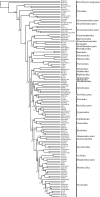Comprehensive gene and taxon coverage elucidates radiation patterns in moths and butterflies
- PMID: 20444718
- PMCID: PMC2981981
- DOI: 10.1098/rspb.2010.0392
Comprehensive gene and taxon coverage elucidates radiation patterns in moths and butterflies
Abstract
Lepidoptera (butterflies and moths) represent one of the most diverse animals groups. Yet, the phylogeny of advanced ditrysian Lepidoptera, accounting for about 99 per cent of lepidopteran species, has remained largely unresolved. We report a rigorous and comprehensive analysis of lepidopteran affinities. We performed phylogenetic analyses of 350 taxa representing nearly 90 per cent of lepidopteran families. We found Ditrysia to be a monophyletic taxon with the clade Tischerioidea + Palaephatoidea being the sister group of it. No support for the monophyly of the proposed major internested ditrysian clades, Apoditrysia, Obtectomera and Macrolepidoptera, was found as currently defined, but each of these is supported with some modification. The monophyly or near-monophyly of most previously identified lepidopteran superfamilies is reinforced, but several species-rich superfamilies were found to be para- or polyphyletic. Butterflies were found to be more closely related to 'microlepidopteran' groups of moths rather than the clade Macrolepidoptera, where they have traditionally been placed. There is support for the monophyly of Macrolepidoptera when butterflies and Calliduloidea are excluded. The data suggest that the generally short diverging nodes between major groupings in basal non-tineoid Ditrysia are owing to their rapid radiation, presumably in correlation with the radiation of flowering plants.
Figures


Similar articles
-
Toward reconstructing the evolution of advanced moths and butterflies (Lepidoptera: Ditrysia): an initial molecular study.BMC Evol Biol. 2009 Dec 2;9:280. doi: 10.1186/1471-2148-9-280. BMC Evol Biol. 2009. PMID: 19954545 Free PMC article.
-
A large-scale, higher-level, molecular phylogenetic study of the insect order Lepidoptera (moths and butterflies).PLoS One. 2013;8(3):e58568. doi: 10.1371/journal.pone.0058568. Epub 2013 Mar 12. PLoS One. 2013. PMID: 23554903 Free PMC article.
-
Phylogenomic data exploration with increased sampling provides new insights into the higher-level relationships of butterflies and moths (Lepidoptera).Mol Phylogenet Evol. 2024 Aug;197:108113. doi: 10.1016/j.ympev.2024.108113. Epub 2024 May 23. Mol Phylogenet Evol. 2024. Retraction in: Mol Phylogenet Evol. 2025 Jan;202:108251. doi: 10.1016/j.ympev.2024.108251. PMID: 38796071 Retracted.
-
Lepidoptera genomes: current knowledge, gaps and future directions.Curr Opin Insect Sci. 2018 Feb;25:99-105. doi: 10.1016/j.cois.2017.12.004. Epub 2017 Dec 23. Curr Opin Insect Sci. 2018. PMID: 29602369 Review.
-
Sex chromosomes and sex determination in Lepidoptera.Sex Dev. 2007;1(6):332-46. doi: 10.1159/000111765. Epub 2008 Jan 18. Sex Dev. 2007. PMID: 18391545 Review.
Cited by
-
Neo-sex chromosomes and adaptive potential in tortricid pests.Proc Natl Acad Sci U S A. 2013 Apr 23;110(17):6931-6. doi: 10.1073/pnas.1220372110. Epub 2013 Apr 8. Proc Natl Acad Sci U S A. 2013. PMID: 23569222 Free PMC article.
-
Identification of the female-produced sex pheromone of Tischeria ekebladella, an oak leafmining moth.J Chem Ecol. 2012 Oct;38(10):1298-305. doi: 10.1007/s10886-012-0184-9. Epub 2012 Sep 30. J Chem Ecol. 2012. PMID: 23053915
-
Evolution and losses of spines in slug caterpillars (Lepidoptera: Limacodidae).Ecol Evol. 2019 Aug 5;9(17):9827-9840. doi: 10.1002/ece3.5524. eCollection 2019 Sep. Ecol Evol. 2019. PMID: 31534697 Free PMC article.
-
Increased gene sampling strengthens support for higher-level groups within leaf-mining moths and relatives (Lepidoptera: Gracillariidae).BMC Evol Biol. 2011 Jun 24;11:182. doi: 10.1186/1471-2148-11-182. BMC Evol Biol. 2011. PMID: 21702958 Free PMC article.
-
A Triassic-Jurassic window into the evolution of Lepidoptera.Sci Adv. 2018 Jan 10;4(1):e1701568. doi: 10.1126/sciadv.1701568. eCollection 2018 Jan. Sci Adv. 2018. PMID: 29349295 Free PMC article.
References
-
- Davis D. R.1986A new family of monotrysian moths from austral South America (Lepidoptera: Palaephatidae), with a phylogenetic review of the Monotrysia. Smith. Contr. Zool. 434, 1–202
-
- Davis D., Robinson G. S.1998The Tineoidea and Gracillarioidea. In Handbook of zoology, vol. IV, Arthropoda: Insecta, part 35, Lepidoptera, moths and butterflies, vol. 1 (ed. Kristensen N. P.), pp. 91–117 Berlin, Germany: Walter de Gruyter
-
- Drummond A. J., Rambaut A.2007BEAST: Bayesian evolutionary analysis by sampling trees. BMC Evol. Biol. 7, 214 (doi:10.1186/1471-2148-7-214) - DOI - PMC - PubMed
-
- Dugdale J. S., Kristensen N. P., Robinson G. S., Scoble M. J.1998The smaller Microlepidoptera-grade superfamilies. In Handbook of zoology, vol. IV, Arthropoda: Insecta, part 35, Lepidoptera, moths and butterflies, vol. 1 (ed. Kristensen N. P.), pp. 217–232 Berlin, Germany: Walter de Gruyter
-
- Epstein M. E., Geertsema H., Naumann C. M., Tarmann G. M.1998The Zygaenoidea. In Handbook of zoology, vol. IV, Arthropoda: Insecta, part 35, Lepidoptera, moths and butterflies, vol. 1 (ed. Kristensen N. P.), pp. 159–180 Berlin, Germany: Walter de Gruyter
Publication types
MeSH terms
Substances
LinkOut - more resources
Full Text Sources

